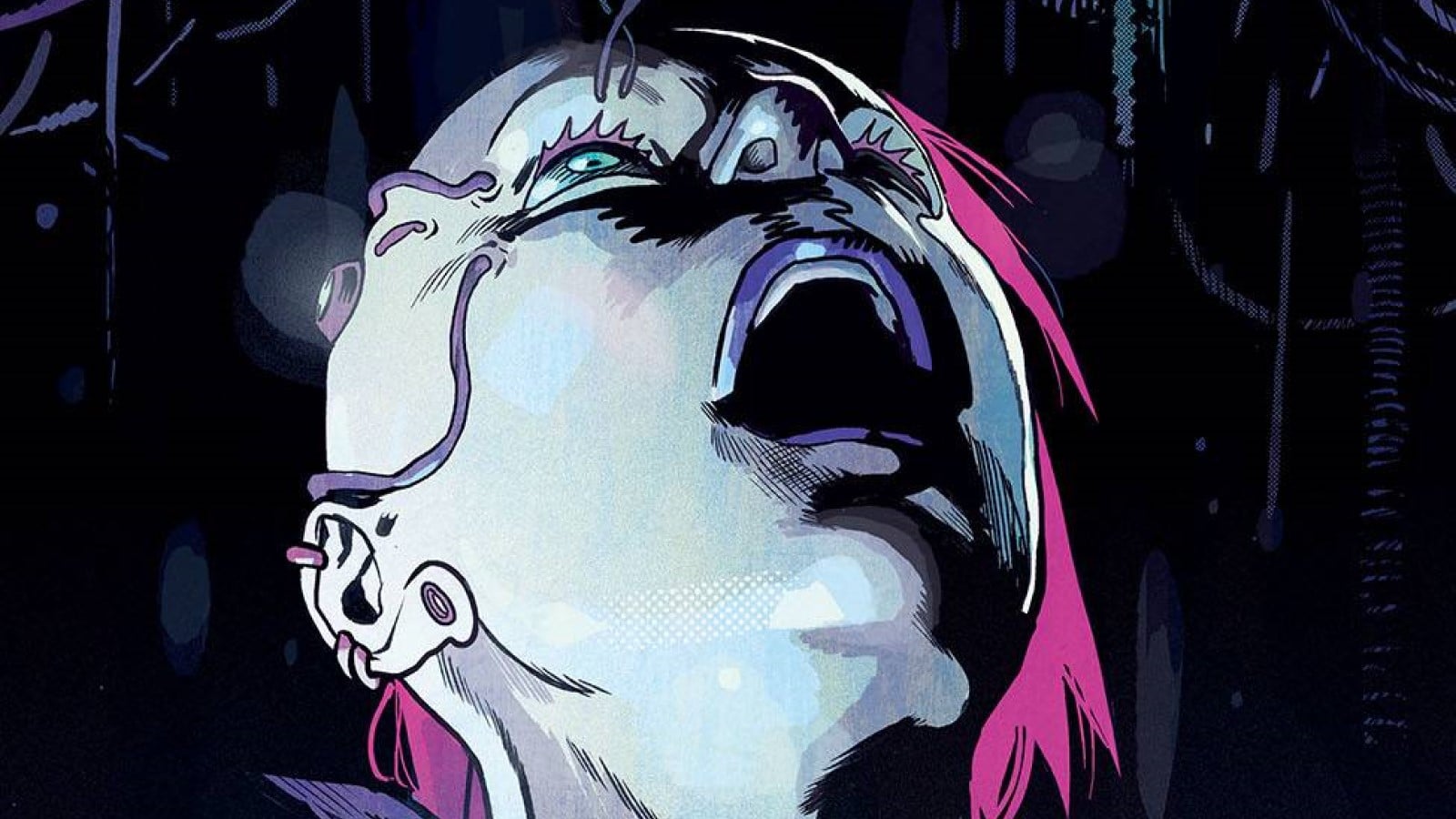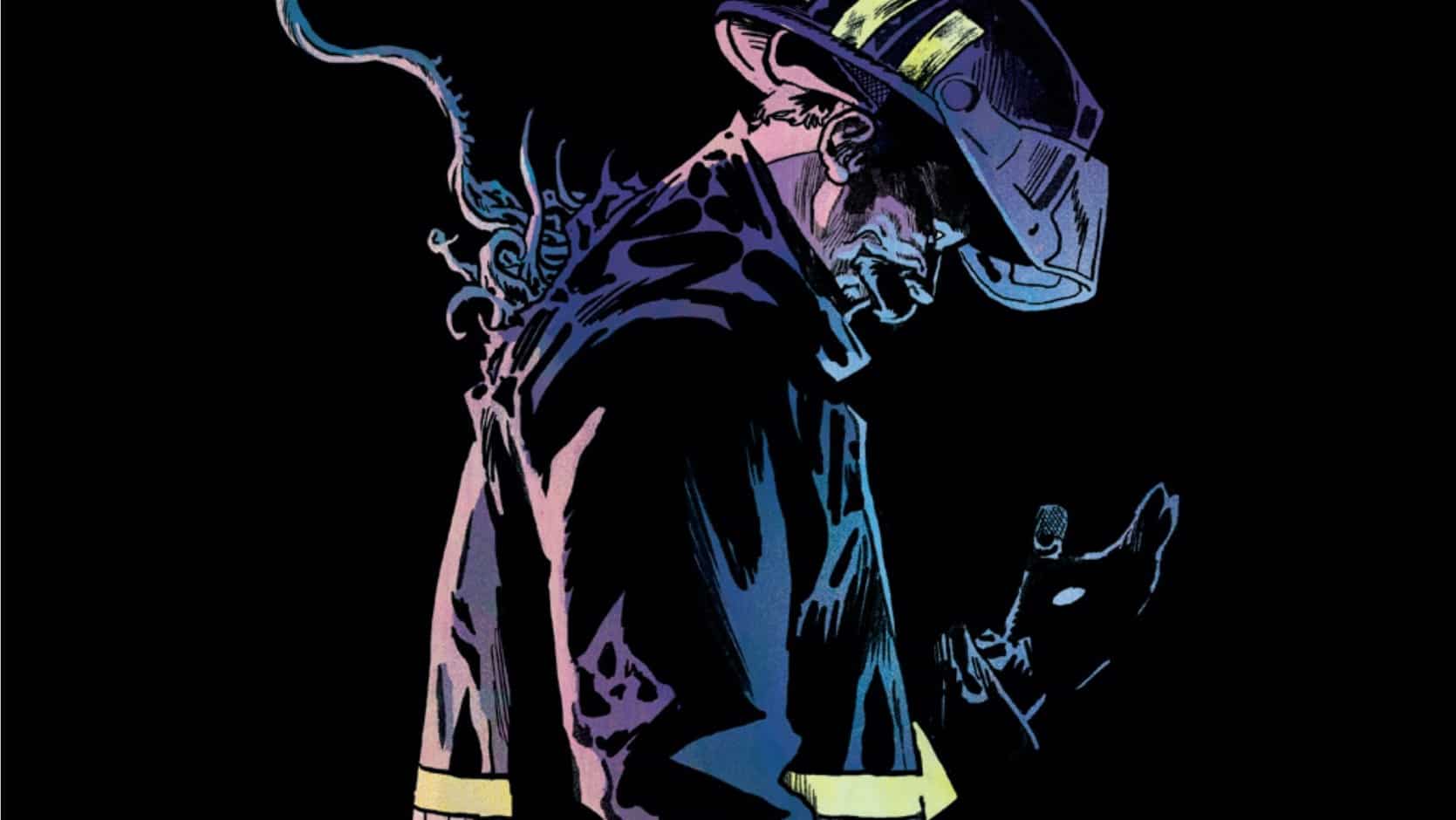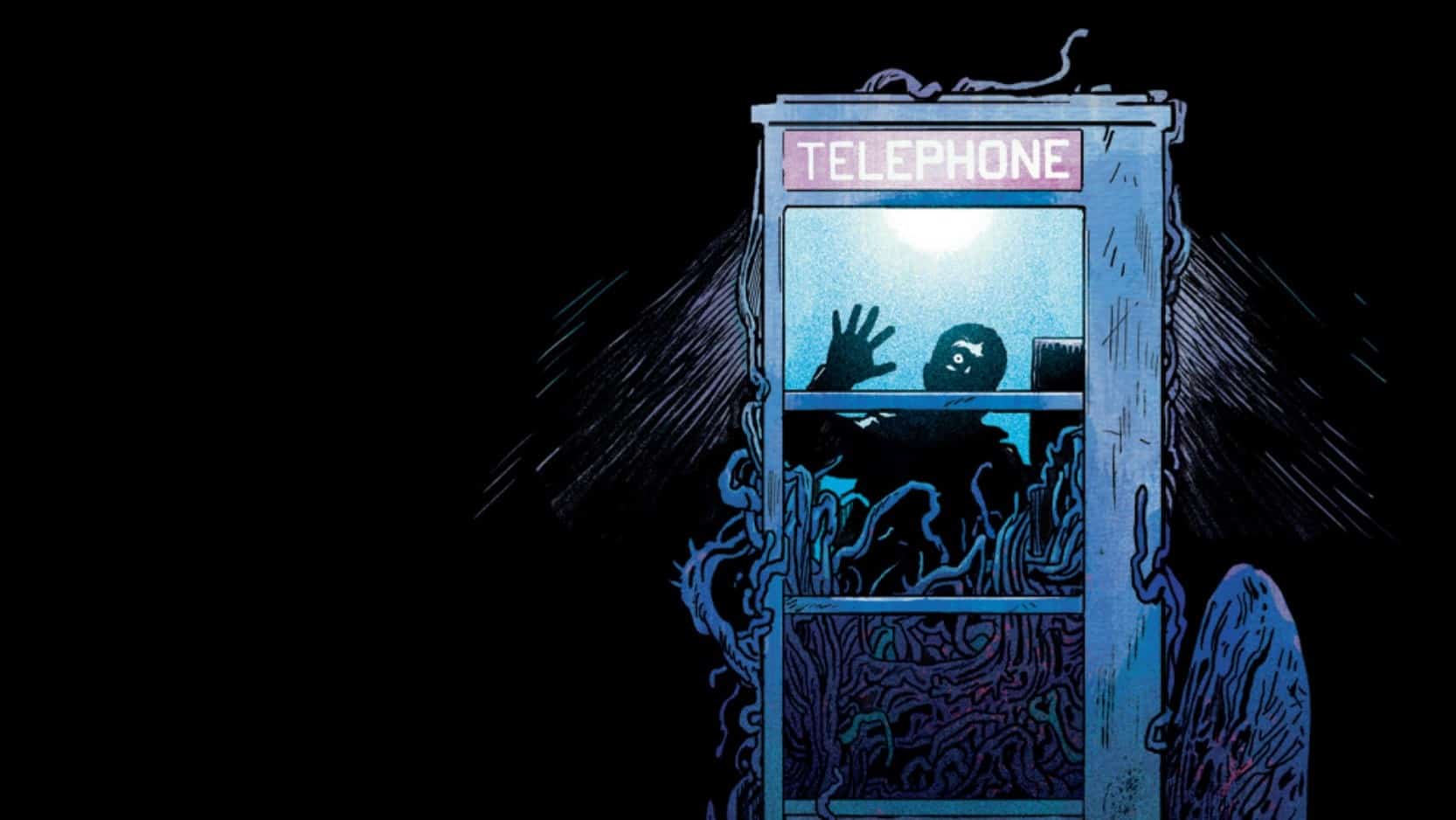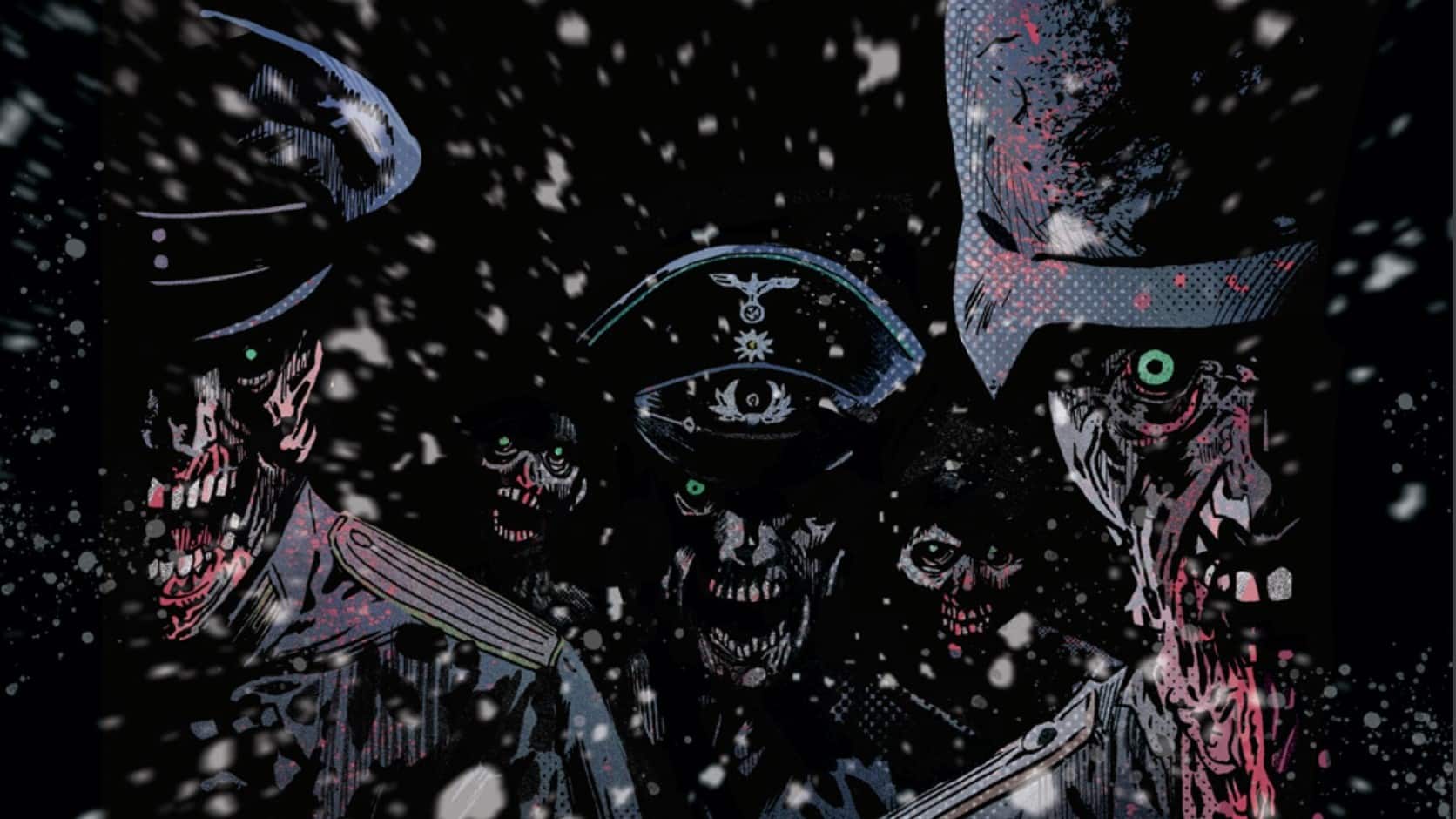The cycle of horror travels far into the future for the fourth issue of The Silver Coin by artist Michael Walsh and writer Jeff Lemire. The year is 2467, and the old world has been buried beneath the junk of a new civilization. From the trash, a scavenger discovers ancient treasure — a coin. The price it carries, however, is unimaginable.
Mark Turetsky: The eye opens, and once again, we are within the thrall of The Coin. Welcome back, Armaan!
Armaan Babu: Back … to the future! I think of all the stories we’ve read so far, this one’s both the strangest and the ickiest, depending on how comfortable you are with worm-infested eye sockets. The future’s so bleak, you gotta wear cybernetic lenses … but horror is eternal.
An Eye on Future Developments

Armaan: So this future is weird, right? I mean, you have the familiar dystopian trappings of a wall between the haves in the city and the have-nots in the wastelands outside, and the existence of a surveillance state, but hacking into people’s digital assets via eye worms is new to me. Perhaps I’ve been reading the wrong books. What did you think about this future, Mark?
Mark: It’s definitely not a great place (time?), all things considered. The eye worm thing is definitely new to me, but also, it’s very much a continuation of the visual motif of eyes. Maybe in the future, technology has tapped into the same ocular access port that the Silver Coin uses to magically possess its victims? Except instead of murder, it’s e-commerce?
Armaan: It definitely feels like The Coin has had a major influence on the future of technology, even if the people of the future aren’t aware of where it came from. Of all the senses, it’s sight that consumes the most — and the most constantly. Podcasts (and shameless plugs for the same) aside, most of the internet is absorbed through our eyes. This future we’re seeing is just a horrific extension of that — ocular hardware and somewhat literal wetware turning eyes into things that absorb everything they can … the eyes are hungry, and terrifying, and we see that for both the oppressors and the oppressed, here.
Mark: There was a belief in ancient Greece, which we now call “emission theory,” where instead of eyes being passive receptors of light, that instead they emitted a ray called “flux” that would then reflect and travel back to the eye. This is kind of like flux, but if flux were worms.
Also, just look at how different the world is within the walls of the city (is it a visual nod to Judge Dredd?) versus outside the city. Inside the city is light, outside is darkness. When we talk about “enlightenment” or “dark ages,” we’re using visual metaphors, so I don’t think it’s a coincidence that eyes play such a huge role in this comic, both metaphorically and literally. That, and obviously, comics is a visual medium.
Armaan: There’s a lot about the specifics of this world that I would love to explore — strange, weird worldbuilding is always a strong hook for me — but we don’t really get a lot of time to figure out how this world works before a chase scene begins. I have to say, there are a lot of similarities between this issue and the last one — both feature female focal characters involved in crime, who are soon chased by the authorities before a voice in their head (coming from The Coin) tells them how to get away.
In this instance, though, it’s interesting that The Coin appears to hack into Bragie’s tech before she even gets close to it — lending further credence to the idea that all this eye-based technology sprung from The Coin itself somehow.
V-eye-rus Detected

Mark: And at first, she doesn’t even seem to realize that something’s hacked into her tech. It seems like it’s just whatever computer she’s got hooked into her brain that’s giving her the instructions. Again, it’s very similar to Lisa’s story last month, where she hears the coin, and it’s indistinguishable to her from an actual sound, so much so that she’s surprised that the others can’t hear it, too. For a coin that seems to have been made by a guy with a pilgrim hat, it’s pretty forward-compatible.
Armaan: That’s the thing — we’re constantly reminded in every title page that a curse needs to feed. Predators adapt. This one seems to have spread its influence, and as Bragie follows its instructions, she discovers a whole world left behind — and while it’s not explicitly stated, it’s all too easy to imagine The Coin being responsible for both the death of the old world, and the corruption of the new.
Forward-compatible as The Coin may be, though, it’s still pretty heavily reliant on old hardware — namely, the raven that causes interference so Bragie has a clear path to it.
Mark: Yeah, the raven is definitely a piece of legacy hardware. And it leads Bragie to the old world underground. I agree with your inference that the world was buried to cover the corruption wrought by The Coin. Especially in the scene where Bragie finds the body of the last holder of The Coin, and we see all of these tendrils or cables or wires coming out of it. It’s very reminiscent of the space jockey from Alien. And in the same way, it’s got an evil thing that’s going to take over/destroy everything it comes in contact with.
Armaan: I like the color shifts for this city. Up on the surface, we have this darkened gray-blue, nighttime dystopia that looks like it’s on the verge of a storm. The broken city below, though, is awash in a surreal green light that sells this feeling of a forgotten city. A mess people have tried to move on from. It’s hard to say where the light source is coming from, but rays of what look like daylight highlight some dark destinies.
The Coin doesn’t even have to call out anymore. It looks so shiny and inviting. I wanted to pick it up, and I’ve been reading this series for four issues now!
A Cursed Cycle

Bragie’s still on the run as she sees The Coin, and when need meets curse, The Coin’s eye awakens. We see indistinct shapes form immediately behind her — the same shapes we saw from last issue, and the tech in her head warns of a virus — one she accepts.
The curse as a virus is an interesting concept, especially when we see how far its influence has spread.
Mark: And it’s terrifying that it’s so compatible with the wetware computer systems everyone uses in the new networked world. Bragie manages to spread the coin’s virus to the drone pilot who’s been pursuing her. It kinda seems like this is the endgame for civilization, if the coin can now propagate over networks and possess everyone.
I think the most frustrating thing about this issue is that we likely won’t see how this all turns out, nor how we got to this point in the future. But it does give a tantalizing glimpse of a future on the verge of being dominated by The Coin.
But I don’t know. Maybe that’s a good thing? Maybe the coin is going to bring peace and love?
Armaan: Considering how bloodlustful The Coin is, I think love is out of the question. I suppose there is a certain peacefulness to being mentally subjugated by an evil curse. But at the speed at which the curse can spread in the future, it’s going to run out of prey pretty soon.
But maybe that’s what happened to the old world. The Coin’s curse ate, and ate, and ate until there was no one left but a handful of survivors who started a new world on the ruins of the old. Maybe The Coin was simply waiting for its foodstock of curse-able humans to replenish itself before calling on someone new and repeating the cycle all over again.
There’s a lot of vagueness in this story, leaving the door open to a lot of speculation. It is so vague, in fact, that the most entertaining part of the story to me is that speculation, rather than the story itself. How well do you think the story works on its own?
Mark: I hate to say it, but I agree with you. While I think just about any of the other issues so far can stand on their own, this one really only has interest if you’re already invested in the coin’s lore. Which is bizarre, because it’s really the most isolated from all of the others and therefore theoretically should stand on its own.
I enjoyed picking out the elements of sci-fi pastiche (There’s also an Akira motorcycle slide, and the tiered cities remind me of Delta City, built on the ruins of Old Detroit in Robocop), and there are some amazing visuals (the download of The Coin “virus” into the drone pilot!), but on the whole I think the distance from our real-life experience keeps the human story from being compelling.
Armaan: Agreed. It’s a story that gives the art a lot to play with — and Walsh’s art has consistently been the best part of each of these books — but there’s not a lot to hold on to past that. Next month, however, we get to see Walsh writing in addition to drawing, and it looks like we’re diving all the way into The Coin’s origin — and I can’t wait.
Mark: One more thing before we go. Lemire’s other horror series (with Andrea Sorrentino), Gideon Falls, also features a similar techno-dystopia. There’s no direct correlation between the two settings (The horror corruption spread via infected people vomiting tons of roaches onto other people, not eye worms), but it’s easy to imagine these two stories taking place in the same universe.
Loose Change
- It’s interesting that the bikes unlock with a credit transfer, implying a future where ownership is extinct — everything’s bought a bit at a time.
- In case my (Armaan’s) stance on eye worms wasn’t clear: Ick. Ick. Ick ick ick ick. No good. Very bad. Ick.
- Is the Silver Coin The Silver Coin, with Walsh possessing and corrupting a different writer each month? [Grote’s note: Whooooooooa]
- No.
- If it is, though, Chip Zdarsky should come back to pen the story about that reveal.







